
Coelogyne is a genus of 594 species, which are sympodial epiphytes from the family Orchidaceae, distributed across India, China, Indonesia and the Fiji islands, with the main centers in Borneo, Sumatra and the Himalayas. They can be found from tropical lowland forests to montane rainforests. A few species grow as terrestrials or even as lithophytes in open, humid habitats. The genera BolborchisLindl., HologynePfitzer and PtychogynePfitzer are generally included here. The genus is abbreviated Coel. in trade journals.
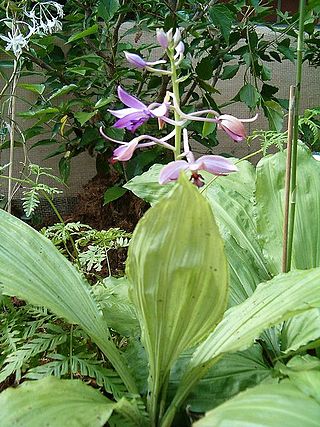
Calanthe, commonly known as Christmas orchids, is a genus of about 220 species of orchids in the family Orchidaceae. They are evergreen or deciduous terrestrial plants with thick roots, small oval pseudobulbs, large corrugated leaves and upright, sometimes arching flowering stems. The sepals and petals are narrow and a similar size to each other and the labellum usually has spreading lobes.
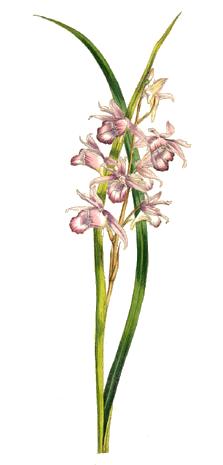
Phaius, commonly known as swamp orchids or in Chinese as 鶴頂蘭屬/鹤顶兰属 , is a genus of forty-five species of flowering plants in the orchid family, Orchidaceae. They are evergreen, terrestrial herbs which form clumps with crowded, sometimes stem-like pseudobulbs, large, pleated leaves and relatively large, often colourful flowers. Species in this genus are found in the tropical parts of Africa, Asia, Southeast Asia, New Guinea, Australia, and various islands of the Pacific and Indian Oceans. One species is also naturalized in Hawaii, Florida, and the Caribbean.

Satyrium is a genus of orchid. The Kew plant list for 2010 listed 85 full species as accepted, ignoring synonyms, subspecies and hybrids etc. About ten were still unresolved at the time. Most of the species occur in sub-Saharan Africa and Madagascar. The ranges of four species extend to Asia, mainly in India and Sri Lanka. Hybridization occurs between several species, complicating molecular phylogenetic studies, especially those relying on mitochondrial and chloroplast DNA sequences.
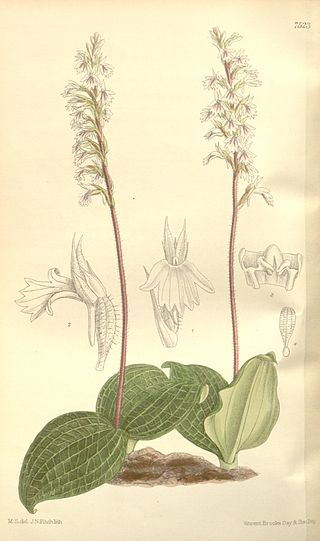
Holothrix is a genus of plants in family Orchidaceae. It contains the following species :
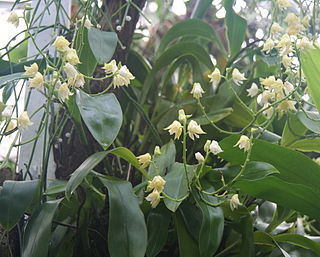
Polystachya, abbreviated Pol in horticultural trade, and commonly known as yellowspike orchid, is a flowering plant genus in the orchid family (Orchidaceae). This rather distinctive genus was described by William Jackson Hooker in 1824 and is the type genus of the subtribe Polystachyinae. It contains about 100 species widespread across many of the tropical areas of the world.

Pinalia, commonly known as gremlin orchids, is a genus of flowering plants in the family Orchidaceae. Orchids in this genus are large epiphytic or lithophytic plants with prominent pseudobulbs, each with up to three thin, flat leaves and cup-shaped, relatively short-lived flowers with scale-like brown hairs on the outside. There are about 120 species occurring from tropical to subtropical Asia to the south-west Pacific.

Phreatia, commonly known as lace orchids, is a genus of flowering plants from the orchid family, Orchidaceae, native to regions bordering the Pacific and Indian Oceans. Plants in this genus are epiphytes, sometimes with pseudobulbs, in which case there are usually one or two leaves. Others lack pseudobulbs but have up to twelve leaves. A large number of small white or greenish flowers are borne on a flowering stem emerging from a leaf axil or from the base of the pseudobulb when present but the flowers do not open widely. There are about 220 species, distributed from tropical and subtropical Asia to the Pacific.

Orthochilus is a genus of orchids that consists of at least 34 species, most of which are native to Africa and Madagascar with a few species in tropical and subtropical America. The genus was first formally described in 1850 by the French botanist Achille Richard, who cited an earlier suggestion by the German botanist Christian Ferdinand Friedrich Hochstetter. Richard recognized a single species, Orthochilus abyssinicus, and noted that the genus shared many features with the closely related genus Eulophia, but differed from it in the form of the pollen masses and caudicule, a stalk to which the pollen masses are attached. The genus Orthochilus has often been viewed as a synonym of the larger genus Eulophia by many botanists, but a recent molecular phylogeny published in 2014 revealed that Eulophia, as traditionally circumscribed, was paraphyletic unless Orthochilus was recognized as a separate genus.

Brachycorythis is a genus of flowering plants from the orchid family, Orchidaceae. It contains approximately 40-50 species native mostly to Africa and Madagascar but also some from South and East Asia.
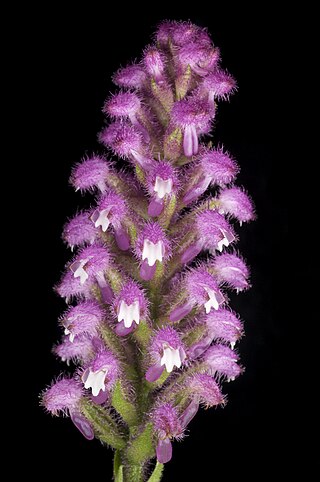
Cynorkis is a genus of flowering plants from the orchid family, Orchidaceae. It is native to tropical and southern Africa, as well as several islands in the Indian Ocean.

Diaphananthe is a genus of flowering plants from the orchid family, Orchidaceae. As currently conceived, it contains 33 accepted species, all endemic to sub-Saharan Africa.
Tridactyle is a genus of flowering plants from the orchid family, Orchidaceae. It has about 60-70 known species, all native to sub-Saharan Africa.
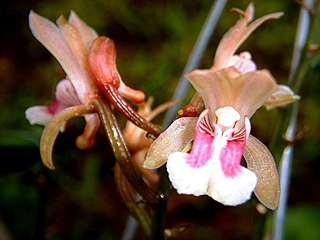
Oeceoclades, collectively known as the monk orchids, is a genus of flowering plants from the orchid family, Orchidaceae. It is related to Eulophia and like that genus is mostly terrestrial in habit. A few species extend into very arid environments, unusual for an orchid.

Bonatea is a genus of orchids native to tropical and southern Africa, with one species extending into Yemen and Saudi Arabia.

















